|
Masterpieces from the Austrian Habsburg Dynasty Brings Imperial Splendor to the High Museum of Art
Posted November 2015

All photos: Kunsthistorisches Museum, Vienna, Austria.
A major American collaboration brings masterworks amassed by one of the longest-reigning European dynasties to the High Museum of Art. “Habsburg Splendor: Masterpieces from Vienna's Imperial Collections,” on view now through Jan. 17, 2016, showcases masterpieces and rare objects from the collection of the Habsburg Dynasty—the emperors of the Holy Roman Empire and other powerful rulers who commissioned extraordinary artworks now in the collection of the Kunsthistorisches Museum in Vienna.
|
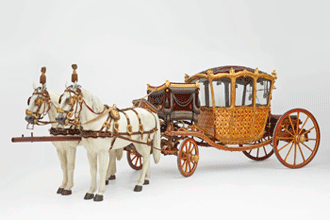
Magnificent Prince's Dress Carriage, ca. 1750-1755, wood, gold, paint, varnish, metal, leather, braids, velvet, and glass, 107 × 204 1/2 × 81 inches. (Photo: Kunsthistorisches Museum, Vienna, Austria.)
|
The exhibition explores the dramatic rise and fall of the Habsburgs’ global empire, from their political ascendance in the late Middle Ages to the height of their power in the 16th and 17th centuries, the expansion of the dynasty in the 18th and 19th centuries to its decline in 1918. The more than 90 artworks and artifacts that tell the story include arms and armor, sculpture, Greek and Roman antiquities, court costumes, a carriage and sleigh, decorative art objects, and paintings by such masters as Correggio, Giorgione, Rubens, Tintoretto, Titian and Velázquez. Key masterpieces traveling for the first time to the U.S. include: The Crowning with Thorns” (c. 1602/1604) by Caravaggio; A portrait of Jane Seymour (1536), Queen of England and third wife to Henry VIII, by Hans Holbein the Younger; and Jupiter and Io” (c. 1530/32) by Correggio.
|
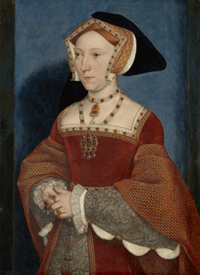
|
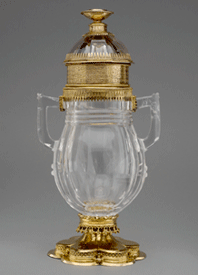
|
|
Jane Seymour (1509-1537, the third wife of Henry VIII) by Hans Holbein the Younger (German, 1497-1543), painted ca. 1536-1537, oil on panel, 25.75 ×16 inches.
|
Lidded vase, so-called Herberstein Cup,1449 (base), 1564 (lid), rock crystal, gilded silver, 9 7/8 x 4 15/16 x 3 3/16 inches.
|
“For many, this exhibition is a once-in-a-lifetime chance to explore hundreds of years of art collecting by the Habsburg family,” said Gary Radke, consulting curator for the High. “Habsburg Splendor: Masterpieces from Vienna's Imperial Collections” chronicles the Habsburgs’ story in three chapters, each featuring a three-dimensional “tableau”—a display of objects from the Habsburgs’ opulent court ceremonies—as context for the other works on view.
Dawn of the Dynasty. This section features objects commissioned or collected by the Habsburgs from the 13th through the 16th centuries. In this late medieval/early Renaissance period, Habsburg rulers staged elaborate celebrations to demonstrate power and to establish their legitimacy to rule, a tradition that flourished during the reigns of Maximilian I and his heirs. Works from this era—including sabers and armor, tapestries, Roman cameos, and large-scale paintings—illustrate the significance of war and patronage in expanding Habsburg influence and prestige. Tableau: Suits of armor displayed on horseback and jousting weapons from a royal tournament, including: armor of Emperor Maximilian I (c. 1492); a bronze bust of Emperor Charles V (c. 1555); a rock crystal goblet made for Emperor Frederick III (1400–1450).
|
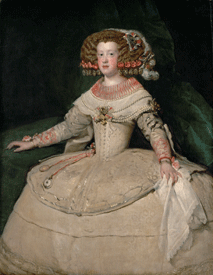
|
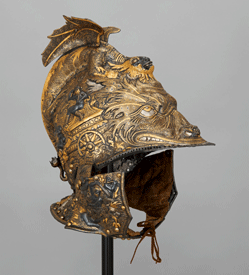
|
|
Infanta Maria Teresa (1638-1683), by Diego Rodríguez de Silva y Velázquez (Spanish, 1599-1660), painted ca. 1652-1653, oil on canvas, 50 × 38 5/16 × 1 inches
|
"All'Antica" Burgonet helmet of Archduke Ferdinand II of Tyrol (1529-1595), ca. 1560; iron, gold, silver, 15 3/16 × 8 1/2 × 12 13/16 inches.
|
Golden Age. The second and largest section highlights the apex of Habsburg rule, the Baroque Age of the 17th and 18th centuries. The dynasty used religion, works of art, and court festivities to propagate its self-image and claim to rule during this politically tumultuous time. Paintings by Europe’s leading artists demonstrate the wealth and taste of the Habsburg rulers, while crucifixes wrought in precious metals and gems, as well as sumptuous ecclesiastical vestments, reflect the emperor’s role as defender of the Catholic faith. Tableau: A procession featuring a Baroque ceremonial carriage and sleigh, an ivory tankard (1642), and Infanta Maria Teresa (1652–53), a portrait of the daughter of Philip IV of Spain and eventual wife of Louis XIV of France by Velázquez.
|
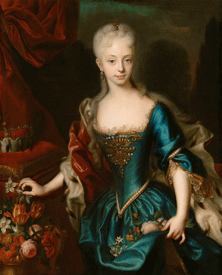
|
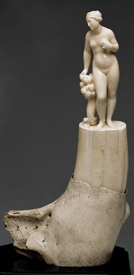
|
|
Empress Maria Theresia (1717-1780) at Age of Eleven, Knee-Length Portrait, c. 1727, by Andreas Möller (Danish, 1684-1762), oil on canvas, 37 x 29.5 inches.
|
Abundantia (Pomona), c. 1635-1645, walrus tooth with scrimshaw by Leonhard Kern (German, 1588-1662), 14 7/8 x 6 15/16 x 5 15/16 inches.
|
Twilight of the Empire. The exhibition concludes with works from the early 19th century, when the fall of the Holy Roman Empire gave rise to the hereditary Austrian Empire—a transition from the ancien régime to a modern state in which merit determined distinction and advancement. Franz Joseph, who reigned longer than any previous Habsburg, saw the growth of nationalism and ruled over a dual monarchy of Austria-Hungary. As heir to the Habsburg legacy—and in the spirit of public education and enrichment—he founded the Kunsthistorisches Museum in 1891. Tableau: Uniforms and women’s gowns from the court of Franz Joseph, including: the campaign uniform of Franz Joseph (1907); a velvet dress made for Empress Elisabeth (c. 1860/65); an evening gown made for Princess Kinsky (c. 1905); the ceremonial dress of Crown Prince Otto for the Hungarian Coronation (1916).
|
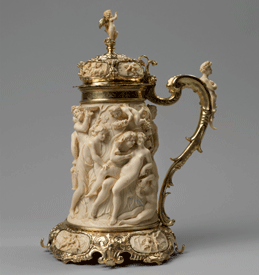
|
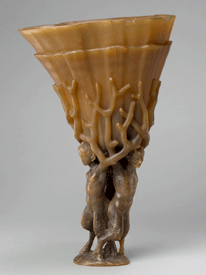
|
|
Ivory Tankard with Lid, 1642, by Hans Jakob I. Bachmann (German, 1574-1651), ivory, gilded silver, 17 1/8 (bottom diameter) x 11 13/16 inches.
|
1610-1612, rhinoceros horn cup, attributed to Nikolaus Pfaff (German, 1556?-1612), 11 11/16 x 6 13/16 inches.
|
A Brief History of the Habsburgs. The noble House of Habsburg rose to prominence in the late Middle Ages through strategic marriages, political alliances and conquest. In 1273, count Rudolph IV gained control of Germany as King of the Romans, and Habsburg domains continued to grow leading up to Pope Nicholas V’s coronation of Frederick III as Holy Roman Emperor in 1452. Under Frederick’s son Maximilian I and his successor Charles V, the Habsburgs achieved world-power status, assuming the title of emperor without papal consent and enfolding Spain and Burgundy into the Habsburg-controlled territories. The dynasty split into Spanish and Austrian branches shortly thereafter, and in the 17th and 18th centuries the male lines died out, resulting in the loss of Spain. In 1740, Maria Theresa—the sole female Habsburg ruler, who reigned for 40 years—seized control of the Austrian line to become the final ruler of the House of Habsburg.
|
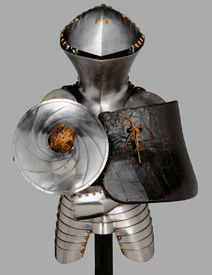
|
Boy’s Armor for Archduke Philipp I of Castile, “The Handsome” (1478-1506), made by Lorenz Helmschmid 1490-1495, iron, brass, leather; shield: wood, leather, 65 x W.39-3/8 x D.23-5/8 inches.
|
The early 19th century witnessed the final demise of the Holy Roman Empire and the establishment of the main Habsburg line’s successors: the House of Habsburg-Lorraine. A hundred years later in 1916, Emperor Charles I inherited a dual Austro-Hungarian monarchy upon the death of longtime Emperor Franz Joseph. More than 600 years of Habsburg sovereignty came to an end in 1918 with the close of WWI.
“Habsburg Splendor,” largely composed of works that have never traveled outside of Austria, was co-organized by the Kunsthistorisches Museum, Vienna, the High Museum, the Minneapolis Institute of Art, and the Museum of Fine Arts, Houston. The Kunsthistorisches Museum is one of the foremost museums in the world with rich holdings comprising artworks from seven millennia, from Ancient Egypt to the late 18th century, including important collections of Renaissance and Baroque art.
---------------------------------------------
All photos, courtesy of Kunsthistorisches Museum, Vienna, Austria.
|